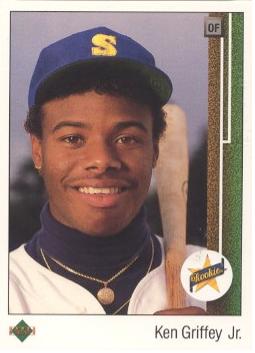SI: How Oversupply Killed The Baseball Card Industry
My sales from ’88 to ’92 were $10,000 to $13,000 a month, and the cost of goods was only $1,000 to $2,000 a month. Then they started putting out so much product, raising the price on packs and putting chase cards that caused people to stop trying to make sets. Kids ran away. Hobbyists got aggravated because they couldn’t afford everything, and speculators backed off because of oversaturation. By ’94 my sales were $3,000 a month, and new products were up to $5,000 a month. I had to get out.
– Bruce Gershenoff, a former baseball card shop owner
Returning to Ken Griffey Jr., it was mentioned earlier that his rookie card is the last one possessing any substantial value due to its relatively low level of issuance in 1989. Such a scenario hasn’t revealed itself again, and with good reason. According to Sports Illustrated, when Yankees’ shortstop Derek Jeter turned pro in the ’90s, no less than eight different cards bearing his likeness were issued. When Albert Pujols entered the major leagues in 2001, there were 43.
– “Baseball Cards And The Current Economy”, John Tamny, Forbes, August 31
Card trading was our pastime, and our issues of Becket Baseball Card Monthly were our stock tickers.
……
This year there are 40 different sets of baseball cards on the market, down from about 90 in 2004. That’s about 38 too many. When there were just two or three major sets on the market, we all had the same small pool of cards. Their images and stats were imprinted on our brains. The baseball card industry lost its way because the manufacturers forgot that the communal aspect of collecting is what made it enjoyable. How can kids talk about baseball cards if they don’t have any of the same ones?
– Dave Jamieson, “Requiem for a Rookie Card”, Slate, July 25, 2006
When I was a kid in the late 1980s, I was an avid baseball card collector as were most of my friends. Baseball cards from when my Dad was growing up were extremely valuable. Me and my friends hoped that one day our collections would be too. We bought packs of cards at the grocery store, scoured card shops, read the monthly Beckett Price Guide like an investor would the stock quotes in The Wall Street Journal, and safe kept our cards in hard plastic cases, plastic sheets and binders. During get togethers and sleepovers we’d trade cards all day (and night) long. To add interest to a game of ping pong or basketball, we’d wager cards on the outcome.
Today, the baseball card industry is a shadow of its former self and many of the cards my friends and I coveted have plummetted in value. In 1991, baseball card sales reached $1.2 billion. But last year, they were only $200 million, according to Sports Collector’s Digest.
What killed the baseball card industry? Inflation.
The Sports Illustrated story on the baseball card industry, “The Last Iconic Baseball Card”, is pretty interesting.
Also check out Real Clear Markets editor and H.C. Wainwright Economics Senior Economist John Tamny’s Forbes article, “Baseball Cards And The Current Economy”, Forbes, August 31.
Finally, for the hardcore, check out Dave Jamieson’s Slate article, “Requiem for a Rookie Card: How Baseball Cards Lost Their Luster”, Slate, July 25, 2006. Jamieson has written a book on the history of baseball cards that will be published next spring.

